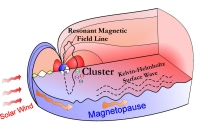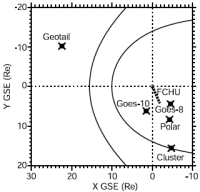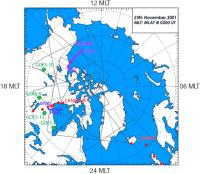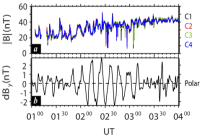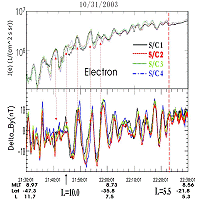Cluster helps reveal how the Sun shakes the Earth's magnetic field
26 July 2007
Space is a hostile region for both astronauts and satellites. One constituent of this hazardous environment around the Earth are very energetic electrons, which are able to perturb or permanently damage satellites. Ultra Low Frequency (ULF) waves, which travel along the Earth's magnetic field lines, are a prime candidate for generating these killer electrons, but the source of these waves remains unclear. A recent study reveals how a rare conjunction of ground based instrumentation and a dozen satellites at a range of altitudes provide a means to trace the energy source of these waves from the solar wind into the Earth's magnetosphere down to the ground. Part of this satellite constellation, the four spacecraft of the ESA Cluster mission, was located at the border of the magnetosphere and played a major role in discriminating between the various theoretical ULF wave generation scenarios.In 1859, the greatest geomagnetic storm ever recorded adversely affected a significant portion of the world's 200 000 km of telegraph lines for several hours, at that time the only means of effective long distance communication. Meanwhile near London (UK), some of the first ground-based magnetometers were monitoring the behaviour of the Earth's magnetic field. Surprisingly, quasi-sinusoidal oscillations of the magnetic field lines with periods of a few minutes were recorded continuously for several hours, as if a celestial musician had plucked the magnetic field lines or strings of the Earth's magnetic guitar (see also "Earth's Magnetic Field" linked from the right-hand side navigation).
These oscillations are now believed to play a significant role in the transport of mass, energy, and momentum within the Earth's magnetosphere. Known as ultra low frequency (ULF) waves, they can effectively accelerate electrons to very high velocities. At geosynchronous altitude (~35 600 km), these highly energetic, so called 'killer', electrons, can inflict critical damage to telecommunications satellites and represent a hazard to astronauts. Understanding how these waves are generated is a strong focus of recent space research.
Several ways of exciting these waves have been proposed. Most of them involve the solar wind as the external driver. The solar wind is a continuous stream of solar particles impacting and shaping the Earth's magnetic environment. However, understanding the global nature of these geomagnetic pulsations and the tracing of the energy transfer from the solar wind to the ground is a difficult task. It requires a fortuitous alignment of several satellites, together with ground–based instruments, to observe the oscillations simultaneously.
A space armada and ground based instruments to track ULF waves
On 25 November 2001, such a serendipitous alignment occurred during the recovery phase of a large geomagnetic storm. A low frequency type of ULF wave, called Pc5, was continuously recorded for many hours by the CARISMA magnetometer chain in Northern Canada. During a 3-hour subset of this interval, these Pc5 waves were picked up by more than a dozen scientific satellites, all collocated in the dusk sector at different altitudes (Image 2a). They included: the four ESA Cluster satellites outbound from the magnetosphere across its boundary, the magnetopause, at altitudes higher than 110 000 km, the NASA Polar spacecraft traversing the magnetosphere at ~58 000 km and four NOAA geostationary satellites at ~35 600 km; GOES-8, -9, -10 and -12 (Image 2b and Animation 1).
The Polar satellite links Cluster data to Ground-Based measurements
A detailed analysis of the data, published in December 2005 in the Journal of Geophysical Research, revealed the following scenario. On 25 November 2001, the solar wind velocity was ~750 kms-1, nearly twice its average speed. The impact of this fast flow of solar particles on the Earth's magnetosphere induced undulations of the magnetopause such as those depicted in Animation 1. As a consequence, the Cluster satellites outbound from the magnetosphere crossed the magnetopause not once but periodically, roughly every 11 minutes or at 1.5 mHz, a typical period for Pc5 waves.
The authors of this study surmise that these undulations induced compressional waves propagating inward from the magnetopause, which coupled to terrestrial magnetic field lines close to the location of Polar (Image 3) and several geosynchronous satellites. All these spacecraft, over a period of hours, picked up clear signatures of this magnetic Field Line Resonance (FLR) with the same period as the magnetopause flapping. Meanwhile, ionospheric signatures of this FLR were measured by SuperDARN HF radars over a large portion of the northern hemisphere (Image 2b). Magnetically conjugated magnetometers of the CARISMA network were recording the ground footprint of this 1.5-1.6 mHz FLR. Taking into account all these data, the authors of this study found that these Pc5 waves result from the excitation of a magnetospheric waveguide either by the Kelvin-Helmoltz instability or via overreflection acting on the duskside magnetopause.
"This excellent conjunction of ground- and space-based instrumentation provides a means to trace energy extracted from the solar wind into the Earth's magnetosphere before ultimately being deposited into the upper atmosphere. During this event, the Polar data provided a direct link between Cluster measurements of magnetopause undulations and FLR signatures detected by SuperDARN radars and the CARISMA magnetometer network. This is the first study to have such an advantageous instrumentation collecting data over the same time interval," comments lead author Dr. Jonathan Rae, scientist at the University of Alberta, Edmonton, Canada and lead author of this study.
"ULF waves affect the entire magnetosphere. This study underlines once again the scientific need of a constant monitoring by ground-based geophysical instruments to put data measured in space in a global context. In situ, Cluster is also revolutionizing our understanding of ULF waves by using the unique capability of its four spacecraft flying in formation, the subject of a PhD very recently defended at Royal Institute of Technology (KTH), Stockholm, Sweden, by Tommy Eriksson," says Philippe Escoubet, ESA Cluster and Double Star project scientist.
Additional Recent Results on ULF Waves
Finally a few words on a very recent result on ULF waves, found thanks to Cluster data and published 29 June 2007 in Geophysical Research Letters. Dr. Qiugang Zong and co-authors report the first direct observations of ULF-energetic particle resonance in the outer Van Allen radiation belt (Image 4).
In particular, the modes of oscillations of the Pc5 waves observed are successfully related to theoretical models and the energy at which the electrons are accelerated by theses waves is quantified. "The results reported in this paper cast new lights to understand very energetic particle acceleration in the Van Allen radiation Belts - the number one space threat," says Dr. Zong, scientist at the University of Massachusetts-Lowell (USA) and at Peking University (China).
Rae, I. J., E. F. Donovan, I. R. Mann, F. R. Fenrich, C. E. J. Watt, D. K. Milling, M. Lester, B. Lavraud, J. A. Wild, H. J. Singer, H. Rème, and A. Balogh (2005), Evolution and characteristics of global Pc5 ULF waves during a high solar wind speed interval, J. Geophys. Res., 110, A12211, doi:10.1029/2005JA011007
Zong, Q.-G., X.-Z. Zhou, X. Li, P. Song, S. Y. Fu, D. N. Baker, Z. Y. Pu, T. A. Fritz, P. Daly, A. Balogh, and H. Rème (2007), Ultralow frequency modulation of energetic particles in the dayside magnetosphere, Geophys. Res. Lett., 34, L12105, doi:10.1029/2007GL029915
Related articles
Mann, I.R., I. Voronkov, M. Dunlop, E. Donovan, T.K. Yeoman, D.K. Milling, J. Wild, K. Kauristie, O. Amm, S.D. Bale, A. Balogh, A. Viljanen, and H.J. Opgenoorth, Coordinated ground-based and Cluster observations of large amplitude global magnetospheric oscillations during a fast solar wind speed interval, Ann. Geophys., 20, 405, 2002.
Advances in Space Research special issue on The Great Historical Geomagnetic Storm of 1859: A Modern Look
Boteler, D.H., The super storms of August/September 1859 and their effects on the telegraph system, Advances in Space Research, 159-172, volume 38, Issue 2, 2006
Recent PhD on the subject
Tommy Eriksson, Multi-point measurements of Ultra Low Frequency waves in the terrestrial magnetosphere, defended on 8 June 2007 at the Royal Institute of Technology (KTH), Stockholm, Sweden [PhD supervisor: Lars Blomberg, KTH].
Contact
Main author
I. J. Rae, Department of Physics, University of Alberta, Edmonton, Alberta T6G 2G7, Canada
E-mail: jrae phys.ualberta.ca
phys.ualberta.ca
Phone: +1-780-492-7284
Q. Zong, Center for Atmospheric Research, University of Massachusetts Lowell, 600 Suffolk Street, Lowell, MA 01854-3629, USA
E-mail: qiugang_zong uml.edu
uml.edu
Phone: +1-978-934-4937
Web story author
Arnaud Masson, SCI-SO division, RSSD, ESA, The Netherlands
E-mail: Arnaud.Masson esa.int
esa.int
Phone: +31-71-565-5634
Web story editors
Philippe Escoubet, SCI-SM division RSSD, ESA, The Netherlands
E-mail: Philippe.Escoubet esa.int
esa.int
Phone: +31-71-565-4564
Arnaud Masson, SCI-SO division, RSSD, ESA, The Netherlands
E-mail: Arnaud.Masson esa.int
esa.int
Phone: +31-71-565-5634
Matt Taylor, SCI-SO division, RSSD, ESA, The Netherlands
E-mail: Matthew.Taylor esa.int
esa.int
Phone: +31-71-565-8009

